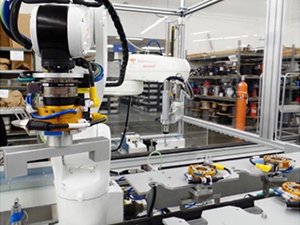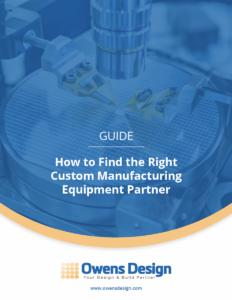6 Reasons Factory Automation Projects Fail

A few years ago, we were hired to create factory automation equipment for a manufacturer that would enable them to scale production. It was a complex job but nothing we couldn’t handle or hadn’t seen before.
The customer’s product was not designed for automation and required a fair amount of back-and-forth between the client and our engineers to develop the prototype equipment. Eventually, we worked out how to automate the hardest part of the process and hit the nail on the head with our second iteration of the machine.
But, when it came time to manufacture the entire line, the company decided to shift production to a supplier that offered them a sweeter financial deal.
Unfortunately, the new supplier failed to deliver the volume of machines the company needed. Worse yet, the machines the manufacturer did produce didn’t work properly.
The result? The company lost tens of millions of dollars, its credibility with investors plummeted, and both the CEO and COO lost their jobs.
We share this anecdote not to shame, but to illustrate the high cost of failure in the outsourced factory automation design and build process. With so much potential financial and reputational loss on the line, it is critically important not to be seduced by shiny new objects. Whether vendors promise lightning-quick turnaround times or multi-million-dollar savings, it’s never wise to go in search of seemingly greener pastures until you have reached a stable and reliable process with your factory automation partner – after all, they’re the ones who understand your products the best.
If you want your factory automation project to succeed, don’t fall prey to these six common mistakes.
1. Changing Companies Mid-Project to Save Money
Once the initial design of your prototype is complete, you might be tempted to search for a manufacturer who can build at a lower cost than your factory automation partner. This temptation flows from the faulty logic that, once a product is designed, anyone can produce it.
Wanting to save money is understandable. Unfortunately, the decision to change companies mid-project often costs more in the long run, even if it shaves some money off the budget initially.
We’ve seen this expensive mistake happen time and again. Something goes wrong during the replication process, so the client has to revert back to the factory automation partner. This failure ends up substantially increasing cost and, more importantly, creates big schedule delays.
The takeaway: don’t move forward without the experts who designed your machine until it is stable. There is no prescriptive figure for this, but generally plan on manufacturing four to five machines before you consider moving to a cheaper manufacturer. The designers and engineers who prototyped your product will make adjustments more effectively than someone who wasn’t involved in the design.
2. Not Designing with a Product Roadmap or Flexibility in Mind
Providing specs for inflexible or overly narrow designs is another “cost cutting” measure that generally ends up costing you more in the long run.
Yes, flexibility can result in a higher up-front costs, but machines designed to be adaptable often save money down the road. It’s not uncommon for clients to discover that their machines – which have already been fully manufactured – lack certain functionality only after they ramp up production. If the product lacks key functionality, clients are forced to design two (or more) separate machines to bridge the gap.
The takeaway: think ahead before providing specs to your factory automation partner and communicate any potential use cases for the machine. The design and engineering team should be able to create a versatile product that gets you more bang for your buck.
3. Not Testing Machines with Appropriate Materials
The foresight applied to functionality should be extended to the variation of materials specified and provided to the equipment development team. Once you have a good understanding of what your machine will do, think carefully about the breadth of materials the machine will need to process.
Resist the temptation to expedite the design process by providing a limited amount and/or variety of materials to test the machine. Dry runs and constrained material runs can provide a snapshot of how a machine will work, but not the full picture. It’s better to discover and correct errors during the design process.
The takeaway: produce and provide your design firm with a fully representative amount and variety of material the machine will use (including imperfect samples). That way, kinks can be worked out early on and you can rest assured that the machine will work reliably in the real world, under normal conditions and use.
4. Falling Prey to Unrealistic Deadlines
We’ve seen this mistake play out in two ways: (1) the client sets unrealistic deadlines or (2) the design and manufacturing partner(s) promise suspiciously fast timelines. Both scenarios typically yield a sub-par result.
When unnecessary, undue pressure is placed on the production process, products suffer. Products shipped before adequate testing frequently experience issues down the road. In our experience, even if there is a penalty for not shipping in accordance with deadlines, it’s best to eat the penalty if the product hasn’t been thoroughly tested or isn’t quite ready. Catching errors while the product is still in-house is far better for your budget and reputation.
The takeaway: don’t heed rushed, artificial deadlines if it means machines leave production with flaws. It’s better to ship a thoroughly tested machine slightly behind schedule than to ship a faulty machine prematurely. Further, if a designer or manufacturer promises to adhere to a timeline that seems too good to be true, it probably is.
5. Not Considering the Total Cost of Ownership
All firms are not created equal. It follows that all hourly rates are not equal. Don’t fall for the fallacy that the lowest rates provide the lowest cost.
The experience of factory automation designers and engineers varies drastically from firm to firm. Often, services that seem like a bargain are priced that way for a reason: discount prices are generally an indication of inexperience. While the initial savings may be tempting, keep in mind the fact that inexperience will cost you in the long run; poorly designed machines are often not as efficient and require more frequent maintenance.
Highly experienced engineers can design and build better products faster with better reliability and serviceability. They identify solutions quickly and design more competently than lower-priced competitors.
The takeaway: don’t overemphasize initial costs – they are trivial compared to the lifespan of your product. Instead, consider the long-term costs of a malfunctioning (or defective) machine. It’s cliche but true: you get what you pay for.
6. Not Working with the Right Factory Automation Partner
Low costs and unbeatable timelines can be tempting but won’t always (and often don’t) culminate in a successful project. Remember, the process is a marathon, not a sprint.
The takeaway: Consider credibility, track record, experience and type of experience before initial costs.
Partner with Owens Design
With 40 years of factory automation design and build services, Owens Design is well acquainted with the mistakes that derail so many projects.
Our team of highly experienced engineers can help you reduce lead time and risk so you can focus on what you do best. Each engineer has an average experience of working on over 40 projects: four per year with at least a decade of experience.
Let our automation experts extend your engineering team with design, production-ready prototyping, and manufacturing of complex technologies. Contact us to learn more.
